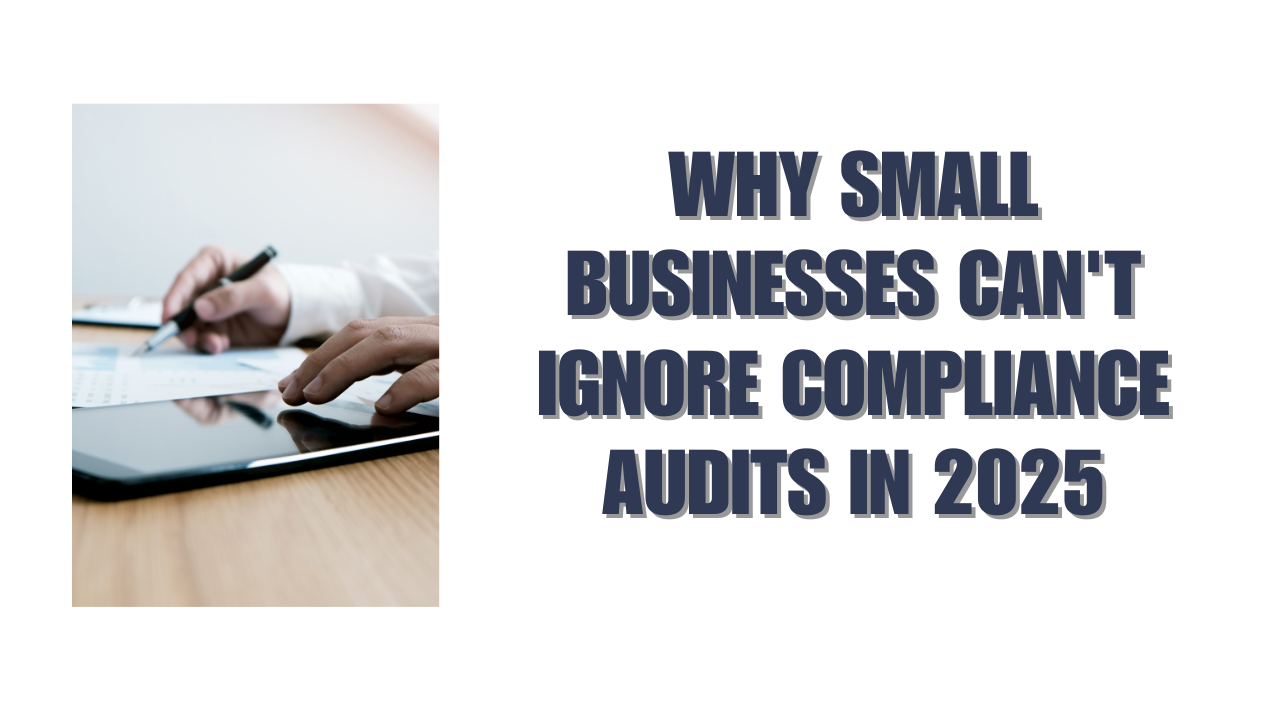Small business compliance audits could save you nearly $2.86 million each year. The numbers are surprising – with over 400 million small-medium businesses worldwide, only 29-30% perform these significant assessments annually. This oversight can get pricey—a compliance audit costs about $12.5 million, while non-compliance expenses can reach a whopping $14.9 million.
Understanding compliance and proper audit procedures has become vital for small businesses heading into 2025. Regular financial audits improve internal controls, prevent fraud, and boost operational efficiency. These audits help detect risks and maintain important certifications like ISO. They also build credibility with potential investors. Regulations keep evolving, which makes the difference between compliance vs internal audit more important. Your business needs a detailed compliance audit checklist to survive. This piece explores compliance audit examples, step-by-step procedures, and useful strategies that will help your small business succeed in today’s heavily regulated marketplace.
What is a Compliance Audit and Why It Matters in 2025
Small businesses need compliance audits to protect themselves from regulatory penalties. A compliance audit is a detailed review that shows how well a business follows voluntary compliance frameworks or regulatory requirements. These formal assessments work like “report cards” to show your company’s compliance health to customers, regulators, and stakeholders.
Definition of compliance audit for small businesses
Compliance audits check if your small business follows external laws and internal policies. These well-laid-out evaluations usually involve document reviews, record inspections, staff interviews, and internal control tests. The audit’s scope changes based on which framework or regulation needs assessment.
During a compliance audit, expect to:
- Provide documentation of internal controls to auditors
- Participate in interviews about compliance processes
- Demonstrate that policies are actively followed
- Receive a formal deliverable detailing your compliance status
Independent third parties conduct most compliance audits and provide a final assessment, report, or audit opinion. This independence builds trust and ensures objectivity with external organizations and customers.
Key regulations affecting SMBs in 2025
Small businesses should watch out for several important regulatory changes in 2025:
Tax changes will substantially affect small businesses because many provisions of the 2017 Tax Cuts and Jobs Act will expire at the end of 2025. On top of that, retirement plan regulations will change. New auto-enrollment requirements for 401(k) and 403(b) plans created after December 2022 will start January 1, 2025.
Plus, almost 70 minimum wage increases at state, local, and industry-specific levels will start January 1, 2025. Eight new state-level AI regulations will emerge between January and October 2025. These rules will address hiring bias, copyright protections, and data privacy breaches.
Compliance vs internal audit: Key differences
People often mix them up, but compliance and internal audits serve different purposes:
| Aspect | Compliance Audit | Internal Audit |
|---|---|---|
| Focus | Regulatory adherence and policy compliance | Evaluating internal controls and processes |
| Responsibility | Ensuring adherence to external laws and regulations | Evaluating and improving internal controls |
| Reporting Structure | Reports to senior management | Reports to Audit Committee, ensuring independence |
| Timing | Often periodic or as required by regulations | Continuous or based on company needs |
| Nature | Primarily focuses on policy enforcement and regulatory alignment | Conducts various audits with emphasis on internal controls |
Internal audits help spot gaps before external compliance audits, which lets businesses prepare fix-it plans. Both types of audits work together to strengthen your business’s risk management framework and make operations more efficient.
Top Risks Small Businesses Face Without Compliance Audits
Small businesses that skip compliance audits put their survival at risk. These threats can quickly grow from minor problems into catastrophic situations that can destroy a business.
Legal penalties and fines for non-compliance
Non-compliance hits businesses hard with hefty regulatory penalties. New Zealand businesses that violate the Fair Trading Act must pay fines up to NZ$1,023,366.16 for each offense. Penalties for Commerce Act violations can reach NZ$17.06 million or triple the commercial gain. Companies that fail to follow GDPR data protection rules face fines up to €20 million or 4% of their worldwide annual revenue, whichever is higher.
These penalties adjust based on business size but can still crush small operations. Companies also face:
- Legal costs from lawsuits
- Remediation expenses
- Possible license revocation
A recent case showed how one subcontractor lost their work on a NZ$170.56 million contract and paid a NZ$341,122.05 fine because they didn’t keep their state contractor license current.
Cybersecurity vulnerabilities and data breaches
Digital information theft has become the leading type of reported fraud, more common than physical theft. Small and medium-sized businesses are targets for 70% of all cyber-attacks. This happens because they lack strong security measures.
A data breach now costs companies NZ$8.32 million on average in 2024. This includes investigation costs, notifying customers, and credit monitoring services. These financial pressures are too much for many small businesses—60% shut down within six months after a breach.
Loss of customer trust and reputational damage
The worst long-term effect of non-compliance is damage to a company’s reputation. Ponemon Institute’s research shows that 65% of customers lose faith in companies after a data breach. About 85% of consumers avoid businesses they don’t trust with their data.
The message is clear—customers won’t support brands they can’t trust. A broken trust is hard to fix. Research shows 29% of customers say they would never return to a business after it experiences a data breach.
How to Conduct a Compliance Audit: A Step-by-Step Guide
Small businesses need a methodical plan to conduct proper compliance audits that meet regulatory requirements. These steps will help you guide this critical process smoothly.
Choosing between internal and external auditors
The difference between internal and external auditors can make or break your compliance success. Internal auditors work as employees who know your business operations inside out and provide budget-friendly ongoing monitoring. External auditors bring independent, unbiased assessments that build credibility with stakeholders. Small businesses with limited resources often find that hiring external consultants to conduct internal audits gives them the best mix of objectivity without getting pricey.
Defining audit scope and objectives
Your audit needs clear boundaries and goals from the start. Begin by identifying which frameworks or regulations you’ll assess. Look at your company’s risk profile to focus on areas that affect compliance impact the most. Then pick specific issues that need scrutiny based on regulatory requirements and industry best practices. This groundwork creates a detailed audit program that shows exactly how to gather evidence.
Compliance procedures in audit: What to include
A solid compliance audit needs these key procedures:
- Inspection: Scrutinizing documents, records, and physical assets
- Observation: Watching processes and security measures in action
- Confirmation: Getting verification from third parties or internal stakeholders
- Reperformance: Running procedures independently to confirm they work
- Analytical procedures: Looking at information to spot unusual trends
- Inquiry: Asking knowledgeable people about compliance practices
Using a compliance audit checklist effectively
A well-laid-out checklist spots process gaps before they turn into expensive problems. Create detailed checklists for each compliance area based on current regulations to get the best results. Gather documentation, talk to people, and watch workplace practices to collect evidence. Compare what you find against requirements to spot gaps, then build a priority-based fix-it plan with specific actions and realistic deadlines.
Real-World Benefits of Regular Compliance Audits
Regular compliance audits offer benefits that go way beyond the reach and influence of avoiding penalties. Small businesses that use these reviews find multiple advantages that directly affect their bottom line.
Operational efficiency and cost savings
Compliance audits help identify workflow bottlenecks and redundancies that slow down business operations. Companies that use systematic assessments often find unnecessary expenses and wasteful practices. Fixing these issues leads to better profits. Studies show companies can save up to NZD 3.41 million on remediation efforts by reducing data breach risks through regular audits. Audits might get pricey at first, but they prevent financial disasters and often cut insurance premiums by 20%.
Improved employee accountability and training
Regular audits change how the workforce performs by setting clear frameworks to monitor resource usage. Compliance training works exceptionally well because it helps employees understand how to perform tasks according to set procedures. This cuts down human error—which causes 80% of compliance and security issues. Companies see a 5% drop in employee turnover and save about NZD 852,810 in hiring and training costs.
Eligibility for certifications like ISO 27001
ISO 27001 certification shows your steadfast dedication to protecting information assets while actively spotting organizational weaknesses. Benefits include:
- Better security against cyber threats
- Greater customer trust and stakeholder confidence
- Edge over non-certified competitors
Organizations start with implementation assessment, then move to certification audit. Annual surveillance audits ensure ongoing conformity over the next two years.
Compliance audit example: GDPR readiness in SMBs
GDPR compliance gives small businesses concrete advantages though it seems overwhelming at first. Breaking the rules risks fines up to €20 million or 4% of global turnover, while proper setup costs between NZD 34,965 to NZD 174,825. All the same, small businesses that use compliance automation platforms can achieve GDPR readiness in just 2-3 weeks instead of a year-long project. Of course, this preparation gives a competitive edge and builds a better reputation for best practices.
Conclusion
Regular compliance audits are a vital shield that protects small businesses from devastating consequences as we approach 2025. This piece shows how the $12.5 million cost of these audits is nowhere near the $14.9 million price of non-compliance. The regulatory landscape changes faster than ever, with most important tax modifications, retirement plan changes, and minimum wage increases planned for 2025.
Small businesses face huge risks without proper compliance measures. Legal penalties can hit millions of dollars even for minor infractions. Cybersecurity vulnerabilities leave businesses open to attacks, and 60% can’t survive beyond six months after an incident. Trust becomes extremely hard to rebuild once it’s broken through non-compliance issues. About 29% of customers say they would never return to businesses after a data breach.
The step-by-step audit process helps spot compliance gaps before they get pricey. A strong compliance framework serves many purposes beyond following regulations when you pick the right auditors, set clear goals, and put thorough procedures in place.
The advantages go way beyond avoiding penalties. Businesses perform better through boosted operational efficiency, cost savings up to $3.41 million, lower employee turnover, and improved security posture. Compliance audits create competitive edges through certifications like ISO 27001 that show your steadfast dedication to security and best practices.
Small business owners should see compliance as a strategic investment in their company’s future, not a burden. The real question isn’t whether you can afford regular compliance audits—but can you afford to skip them?
FAQs
Q1. Why are compliance audits crucial for small businesses in 2025?
Compliance audits are essential for small businesses in 2025 due to evolving regulations, potential legal penalties, and cybersecurity risks. They help businesses avoid costly fines, protect against data breaches, and maintain customer trust, which is crucial for long-term success.
Q2. How often should small businesses conduct compliance audits?
Small businesses should conduct compliance audits regularly, typically on an annual basis. However, the frequency may vary depending on industry regulations and the company’s risk profile. Some businesses may benefit from more frequent audits, especially in rapidly changing regulatory environments.
Q3. What are the key differences between compliance audits and internal audits?
Compliance audits focus on adherence to external laws and regulations, while internal audits evaluate internal controls and processes. Compliance audits are often conducted periodically as required by regulations, whereas internal audits can be continuous based on company needs.
Q4. How can small businesses prepare for a compliance audit?
Small businesses can prepare for a compliance audit by defining clear audit objectives, creating detailed checklists based on current regulations, gathering relevant documentation, and conducting internal reviews. It’s also helpful to train employees on compliance procedures and consider using compliance automation platforms.
Q5. What are the potential consequences of failing a compliance audit?
Failing a compliance audit can result in severe consequences, including substantial financial penalties, legal action, loss of business licenses, reputational damage, and loss of customer trust. In extreme cases, it can lead to business closure, especially if the non-compliance issues result in significant data breaches or regulatory violations.






